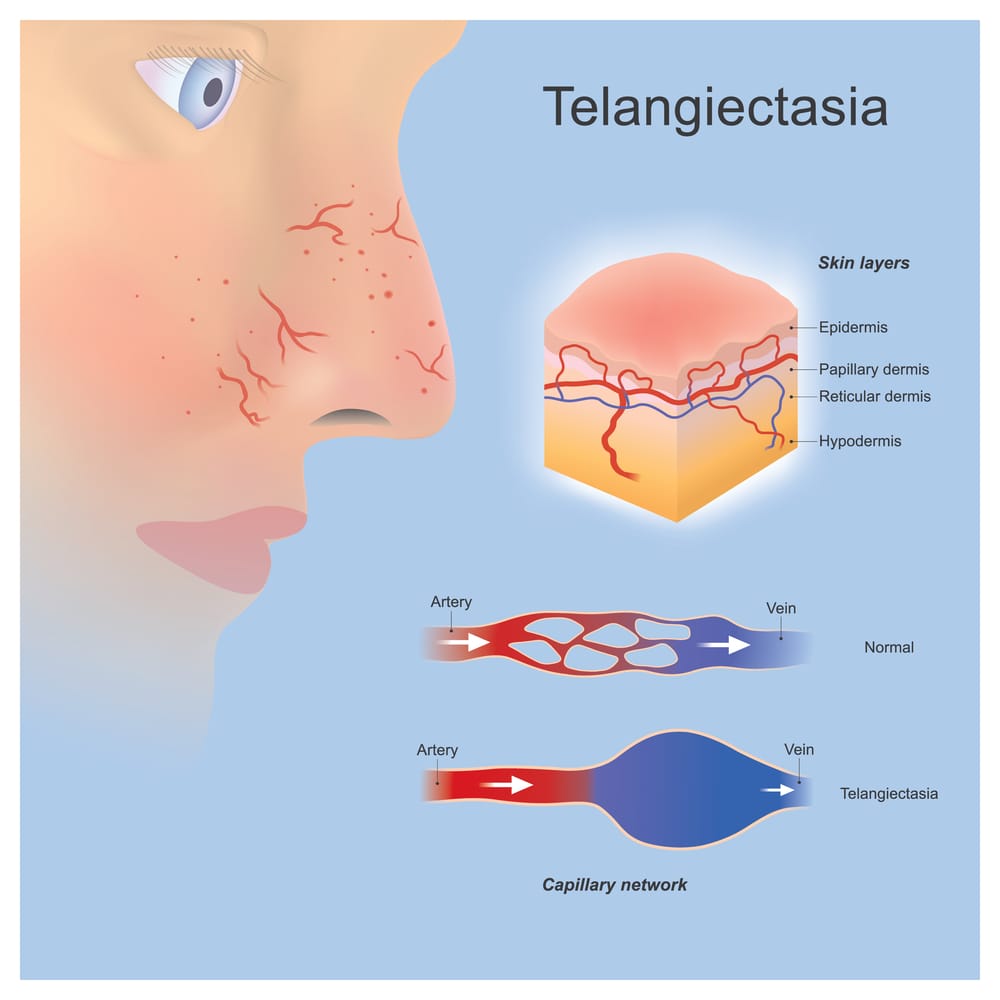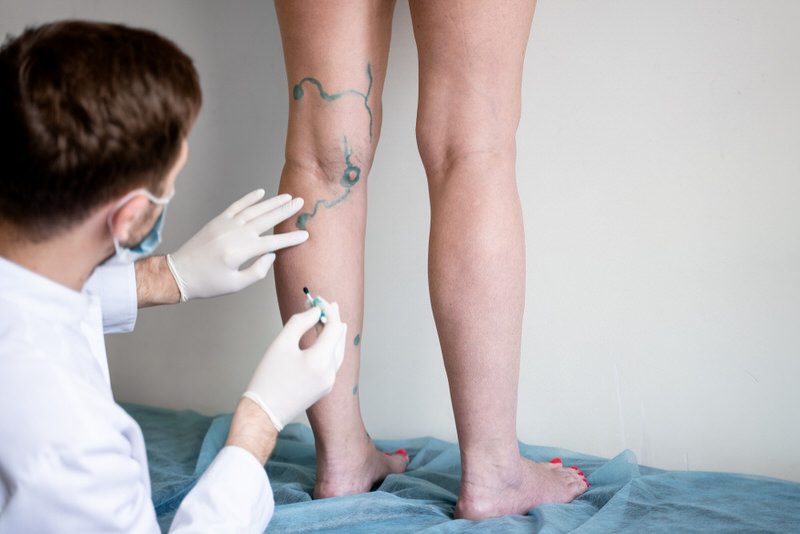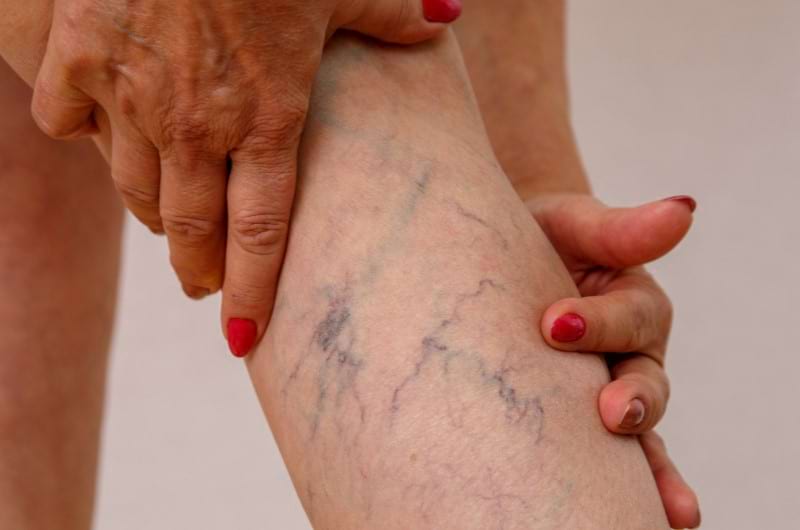If you notice spider veins on your ribcage, you might have a condition called telangiectasia, where the tiny blood vessels cause threadlike red lines or patterns on the skin. Not life-threatening, but these spider veins can sometimes be uncomfortable or cause itching and redness. Multiple factors such as genetic, environmental, or a combination of both can lead to the formation of spider veins. Based on family history and performing some tests, you can help formulate a treatment plan to treat spider veins.
If you’ve noticed small thread-like red blood vessels forming near your rib cage and wondered what it is, you might have Telangiectasias, known as spider veins.
Many people might have these spider veins. While most don’t notice it as it’s somewhere on their body, they don’t see it often. For others, they might have it in very prominent places.
Depending on person to person, they usually aren’t bothersome for some.
For others, it can be a sign of serious illness. So let’s try to understand more about telangiectasia.
What are the causes? Is there anything you can do about it? What kind of treatment is there to make them disappear?
Let’s explore all these questions; hopefully, you’ll get a clearer picture of your issue.
What are spider veins? (Telangiectasia)
The small blood vessels you see on your ribcage must look like spider veins to you as they are very thin and spread like a spider’s web on your ribcage.

This condition is called telangiectasia, in which widened venules (tiny blood vessels) cause threadlike red lines or patterns on the skin.
They sit near the surface of the skin or mucous membranes and are often formed in clusters.
These spider veins usually form in areas like lips, nose, eyes, fingers, and cheeks but can also form near your ribcage.
Symptoms of spider veins
Other than how they might appear and their color, there are no other apparent symptoms of spider veins if it’s not serious.
So, if you see these threadlike spider veins appearing on your body parts, that’s when you know you might have telangiectasia.
- They might be pink or red in color and whiten under pressure. They can even appear in other colors, such as blue or purple.
- Measuring between 1 and 3 millimeters, they are usually harmless but can cause itching and pain if the condition worsens.
- They usually appear on your face but might appear on other body parts like legs, ribcage, back, and arms.
- This spider telangiectasia usually has a red central feeding vessel with outward branches.
- They can become uncomfortable if getting serious. Health and beauty products that cause skin irritation can worsen your condition, such as using harsh soaps and sponges.
Causes of spider veins

It’s still unclear how these spider veins come into existence.
Researchers find that multiple causes might contribute to their existence. These may be genetic, environmental, or even a combination of both.
- Chronic exposure to sun or extreme temperatures. Usually, appearing on the skin, mainly exposed to sunlight and air.
- Alcohol addiction can affect the flow of blood vessels and can cause liver disease.
- Pregnant women are more exposed to getting spider veins as significant pressure is put on their blood vessels as the baby grows.
- As people begin to age, the blood vessels weaken.
- Rosacea is a chronic disease that also causes blood vessels to enlarge, creating a flushed appearance in your cheeks and nose.
- Habitual usage of corticosteroids also thins and weakens the skin.
- Systematic sclerosis is an autoimmune disorder that hardens and contracts the skin.
- Dermatomyositis is a rare inflammatory disease that leads to inflamed skin and underlying muscle tissue.
- Systematic lupus erythematosus can increase skin sensitivity to sunlight and extreme temperatures.
Diagnosing spider veins
Once you see the threadlike veins appearing on your body parts, it’s a pretty apparent telltale that you have telangiectasia.
Depending on the diagnosis, people seek treatment as early as possible when they become aware of their spider veins.
There could be the possibility of it being in the family history.
Physical examination
Physical examinations are conducted where the doctor will observe spider veins to assess their appearance and location.
Doctors focus on observing the threadlike lines on the skin.
They consider additional factors such as medical history, family history, and exposure to potential triggers like sunlight and wind.
Medical tests
Multiple tests could be performed, including blood tests, CT scans, liver function studies, MRI scans, and X-rays.
Treating spider veins

Your spider veins might not completely disappear, but there is a way to treat them to some extent.
Based on your diagnosis and family history, your doctor will bring together a treatment plan that can work for you.
Many people choose to remove spider veins.
It’s possible with laser surgery, sclerotherapy, or excision surgery to remove telangiectasia.
Laser surgery
Many people choose this type of treatment to remove their spider veins because it’s minimally invasive and the most straightforward treatment.
With this method, the widened blood vessels are sealed. It involves a little pain, but there is a short recovery period.
Sclerotherapy
Sclerotherapy is more beneficial for larger veins, such as on your legs. Your doctor will inject salt water or a chemical solution into the affected veins.
This will lead veins to harden and disappear. It’s neither painful nor requires a recovery time period. But the treatment in itself is time taking.
It’s costly and isn’t generally covered under your insurance as they consider spider veins to be cosmetic in nature.
Excision surgery
Excision surgery can remove the widened blood vessels. It’s very painful and might require an extended recovery time period.
Home remedies
Several home remedies too can help manage spider veins. Although they can’t remove them completely, it can help reduce their appearance and manage the pain or discomfort.
These remedies include:
- Exercising regularly to improve circulation and maintain a healthy weight.
- Elevating the affected area whenever possible to relieve pressure on the veins.
- Wearing compression garments can help increase blood flow and reduce the appearance of spider veins.
- Applying a topical ointment or cream containing vitamin K or retinol to help strengthen the walls of the blood vessels.
Other diseases associated with spider veins
When diagnosing, your doctor may also perform specific other tests to see if there’s any other underlying disorder.
There could be other diseases associated with telangiectasia, such as:

1. Osler-Weber-Rendu syndrome (HHT)
Also known as hereditary hemorrhagic telangiectasia, HHT is an inherited disorder of the blood vessels in the skin and internal organs that can cause excessive bleeding and is a potentially life-threatening version of telangiectasia.
In this case, spider veins form on vital organs such as the liver and can burst, causing massive bleeding.
2. Sturge-Weber disease
It’s a rare disorder that can affect the nervous system problems.
It is present at birth and characterized by a port-wine stain birthmark on the forehead and one eyelid on one side of the face.
3. Spider angiomas
An abnormal collection of blood vessels near the surface of the skin. They leave a red to purple mark on your skin and don’t cause any pain.
Children and young adults often grow out of it, and if you get them during your pregnancy, it will go away gradually once you give birth.
4. Xeroderma pigmentosum
It is a rare condition in which the skin and eyes are extremely sensitive to ultraviolet light.
It’s a rare autosomal recessive genodermatosis resulting from mutations in nucleotide excision repair.
When to consult a doctor?
Hereditary Hemorrhagic Telangiectasia, or HHT, is more of a severe version of telangiectasia related to spider veins.
It’s a rare genetic condition that can also be life-threatening.
Instead of forming and showing up on the skin, these spider veins form on vital organs, such as the liver.
The issue which makes it life-threatening is that it may burst to cause massive bleeding.
The symptoms include:
- Frequent nosebleeds
- Red or dark black blood in stools
- Shortness of breath
- Seizures
- Small strokes
- Port-wine stain birthmark
The causes of HHT are genetic, and people with this condition might inherit it from at least one parent.
Five genes are suspected of causing HHT, and three are known.
People with HHT receive either one normal gene and one mutated gene or two mutated genes.
HHT may cause the formation of abnormal blood vessels called arteriovenous malformations. These may occur in several areas of the body.
These AVMs allow direct connection between arteries and veins without intervening capillaries.
This might result in bleeding and is deadly if it occurs in the brain, liver, or lungs.
It can be treated by blocking or closing the blood vessels using embolization, laser therapy to stop bleeding, or surgery.
If done right, people with HHT can also have a normal lifespan.
FAQs
What causes spider veins on the rib cage?
There is no particular reason why there are spider veins on your ribcage. Generally, they appear on the skin; if HHT, they might be on your liver and won’t be visible.
These are caused when fat builds up in the liver from fatty liver disease and blood flow sluggishly clots, impacting blood pressure.
Are spider veins itchy?
Spider veins are generally not itchy, but if they’re, it might be because your condition is serious.
You might feel redness, itchiness, and inflammation to some extent.
Do spider veins ever go away?
Depending on your condition, family history, and treatment plan, your doctor might treat your spider veins and make them disappear completely.
There are various treatment plans, and based on what is recommended, you might tell the time taken to treat it.
How do you stop spider veins from spreading?
* Exercising will help keep your muscles tight
* Controlling your weight to put less pressure on your legs
* Wearing compression stockings
* Don’t stand for a longer period
* Elevate your legs when standing
What vitamin deficiency causes spider veins?
Vitamin C helps strengthen your veins and is essential in helping your body produce collagen and your veins stay strong and flexible.
When you don’t have enough vitamin C in your diet, the vein valves lose their strength and have difficulty pumping blood back to the heart.
As the blood pool in the vein, a visible spider vein forms.
Do spider veins mean poor circulation?
As you age, gain weight, or have valves that weaken your veins may allow your blood to flow backward, ‘reflux,’ or pool in your legs.
This stagnant blood flow enlarges your veins, making them more visible, causing spider and varicose veins.
Since your blood isn’t moving in the correct direction, to begin with, you start seeing blue and red lines beneath the surface of your skin.
Your poor circulation is causing the spider veins to develop and expand.
References
- https://www.cdc.gov/ncbddd/hht/index.html#:~:text=HHT%20is%20a%20disorder%20in,present%20between%20arteries%20and%20veins.
- https://www.healthline.com/health/sclerotherapy
- https://www.healthline.com/health/systemic-lupus-erythematosus
- https://www.hss.edu/conditions_telangiectasia-and-autoimmune-disease.asp#:~:text=treatments%20for%20telangiectasia%3F-,What%20is%20telangiectasia%3F,which%20temporarily%20whiten%20when%20pressed.
- https://www.medicalnewstoday.com/articles/320282


